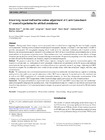A learning-based method for online adjustment of C-arm Cone-beam CT source trajectories for artifact avoidance
dc.contributor.author
Thies, Mareike
dc.contributor.author
Zaech, Jan-Nico
dc.contributor.author
Gao, Cong
dc.contributor.author
Taylor, Russell
dc.contributor.author
Navab, Nassir
dc.contributor.author
Maier, Andreas
dc.contributor.author
Unberath, Mathias
dc.date.accessioned
2020-11-11T15:50:54Z
dc.date.available
2020-09-08T03:22:28Z
dc.date.available
2020-09-09T10:51:00Z
dc.date.available
2020-11-11T15:50:54Z
dc.date.issued
2020-11
dc.identifier.issn
1861-6410
dc.identifier.issn
1861-6429
dc.identifier.other
10.1007/s11548-020-02249-1
en_US
dc.identifier.uri
http://hdl.handle.net/20.500.11850/438990
dc.identifier.doi
10.3929/ethz-b-000438990
dc.description.abstract
Purpose During spinal fusion surgery, screws are placed close to critical nerves suggesting the need for highly accurate screw placement. Verifying screw placement on high-quality tomographic imaging is essential. C-arm cone-beam CT (CBCT) provides intraoperative 3D tomographic imaging which would allow for immediate verification and, if needed, revision. However, the reconstruction quality attainable with commercial CBCT devices is insufficient, predominantly due to severe metal artifacts in the presence of pedicle screws. These artifacts arise from a mismatch between the true physics of image formation and an idealized model thereof assumed during reconstruction. Prospectively acquiring views onto anatomy that are least affected by this mismatch can, therefore, improve reconstruction quality. Methods We propose to adjust the C-arm CBCT source trajectory during the scan to optimize reconstruction quality with respect to a certain task, i.e., verification of screw placement. Adjustments are performed on-the-fly using a convolutional neural network that regresses a quality index over all possible next views given the current X-ray image. Adjusting the CBCT trajectory to acquire the recommended views results in non-circular source orbits that avoid poor images, and thus, data inconsistencies. Results We demonstrate that convolutional neural networks trained on realistically simulated data are capable of predicting quality metrics that enable scene-specific adjustments of the CBCT source trajectory. Using both realistically simulated data as well as real CBCT acquisitions of a semianthropomorphic phantom, we show that tomographic reconstructions of the resulting scene-specific CBCT acquisitions exhibit improved image quality particularly in terms of metal artifacts. Conclusion The proposed method is a step toward online patient-specific C-arm CBCT source trajectories that enable high-quality tomographic imaging in the operating room. Since the optimization objective is implicitly encoded in a neural network trained on large amounts of well-annotated projection images, the proposed approach overcomes the need for 3D information at run-time.
en_US
dc.format
application/pdf
en_US
dc.language.iso
en
en_US
dc.publisher
Springer
en_US
dc.rights.uri
http://creativecommons.org/licenses/by/4.0/
dc.subject
Tomographic reconstruction
en_US
dc.subject
Metal artifact reduction
en_US
dc.subject
Deep learning
en_US
dc.subject
Image-guided surgery
en_US
dc.title
A learning-based method for online adjustment of C-arm Cone-beam CT source trajectories for artifact avoidance
en_US
dc.type
Journal Article
dc.rights.license
Creative Commons Attribution 4.0 International
dc.date.published
2020-08-14
ethz.journal.title
International Journal of Computer Assisted Radiology and Surgery
ethz.journal.volume
15
en_US
ethz.journal.issue
11
en_US
ethz.journal.abbreviated
Int J CARS
ethz.pages.start
1787
en_US
ethz.pages.end
1796
en_US
ethz.version.deposit
publishedVersion
en_US
ethz.identifier.wos
ethz.identifier.scopus
ethz.publication.place
Heidelberg
en_US
ethz.publication.status
published
en_US
ethz.date.deposited
2020-09-08T03:22:32Z
ethz.source
WOS
ethz.eth
yes
en_US
ethz.availability
Open access
en_US
ethz.rosetta.installDate
2020-11-11T15:51:08Z
ethz.rosetta.lastUpdated
2023-02-06T20:59:58Z
ethz.rosetta.versionExported
true
ethz.COinS
ctx_ver=Z39.88-2004&rft_val_fmt=info:ofi/fmt:kev:mtx:journal&rft.atitle=A%20learning-based%20method%20for%20online%20adjustment%20of%20C-arm%20Cone-beam%20CT%20source%20trajectories%20for%20artifact%20avoidance&rft.jtitle=International%20Journal%20of%20Computer%20Assisted%20Radiology%20and%20Surgery&rft.date=2020-11&rft.volume=15&rft.issue=11&rft.spage=1787&rft.epage=1796&rft.issn=1861-6410&1861-6429&rft.au=Thies,%20Mareike&Zaech,%20Jan-Nico&Gao,%20Cong&Taylor,%20Russell&Navab,%20Nassir&rft.genre=article&rft_id=info:doi/10.1007/s11548-020-02249-1&
Files in this item
Publication type
-
Journal Article [128858]

